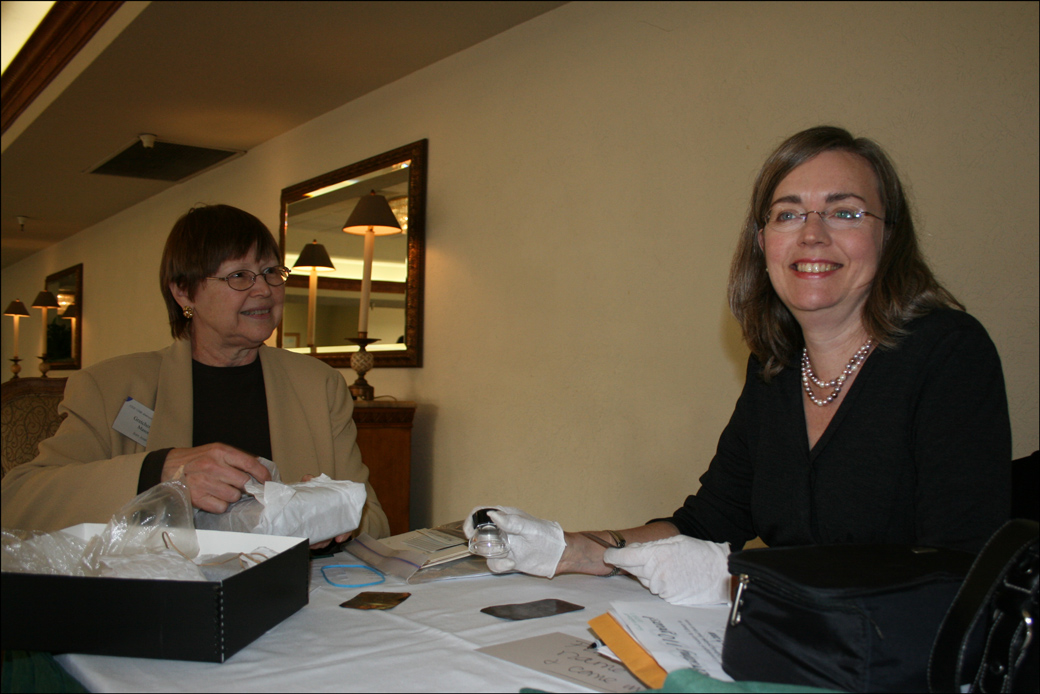On Saturday, I attended the 110th Anniversary Celebration of the California Genealogical Society which included a full day of seminars and one-on-one consultations with Maureen A. Taylor, the Photo Detective.
The Photo Detective at Work
Gretchen Mason shows Maureen Taylor her collection of old photographs in a one-on-one consultation as part of the California Genealogical Society’s 110th Anniversary Celebration on Saturday, 09 Feb 2008 .
SOURCE: The Photo Detective at Work. Photographed by Stephen J. Danko on 09 Feb 2008.
Maureen presented four lectures on Saturday.
Tales from The Photo Detective
In Maureen’s first seminar of the day, she showed examples from her column in Family Tree Magazine and from the photos she has posted on her blog each month. She explained that she looks for interesting photographs discarded by others and found in flea markets and antique stores.
There’s a lot going on in photographs, more than first meets the eye. Why didn’t the subjects of the photographs smile? Was the baby in the photograph alive or dead? Whose photos are on the wall of the house? Does the man is the photograph have a glass eye?
Identifying and Dating Family Photos
In Maureen’s second seminar, she discussed some of the types of old photographs:
-
Dageurreotypes (from 1839 -Â c.1865; on silver plate – the image is reversed),
-
Ambrotypes (on glass),
-
Tintypes (from mid 1850s – 20th Century; on steel, not tin – they will be attracted to a magnet),
-
Paper Prints (from the 1850s – if they are blue, they are cyanotypes)
Maureen also discussed photo identification techniques including photographers’ imprints, tax stamps, and the clothing worn by those in the photograph. She showed examples from several decades in the 19th Century and early 20th century, illustrating long hair on men and tight sleeves on women in the 1840s, shawl collared vests and coats in the 1850s, coats past the knees in the 1860s, hair behind the ears and poses with less restraint in the 1870s, women with oiled hair and men with moustaches and bowler hats in the 1880s, and women with leg-of-mutton sleeves and men with short hair in the 1890s.
Maureen’s message for photo identification was to look at all the details in the picture and add up the clues.
Preserving Family Photographs
After lunch (and a fine lunch it was), Maureen discussed causes of damage to photographs: unstable temperature and humidity, light (including UV light), pollution, handling, pests, mold, water, chemicals, and poor storage materials. She mentioned that photos should be stored in the same materials used in archives (acid free, lignin free, non-PVC plastic) but cautioned that there are no standards for labeling materials “archival”. She recommended Hollinger Corporation and Light Impressions as sources for suitable storage materials.
Maureen left the audience with several cautions about old photographs. Daguerreotypes are very fragile; do not attempt to take them apart to clean them. Ambrotypes are susceptible to breakage, since they are on glass. Tintypes, being on iron plate, are susceptible to bending, rust, abrasion, and lift-off of the emulsion. Paper prints can fade and are susceptible to chemical damage, mold, acid from storage materials, and curling.
Maureen also cautioned against “magnetic” photo albums, since the adhesive in those albums can damage the photographs. She also provided recommendations for printing digital images, with a particular emphasis on inks, including Epson’s DURABrite, Canon’s Pixma, and HP’s Vivera inks. For labeling photos, Maureen recommended a soft lead pencil or Zig markers (bleed-proof, fade-proof).
Reading Immigrant Clues in Photos
Maureen’s final presentation discussed how to read clues in immigrant photos. Immigrants may have posed for pictures when they left their homeland or when they arrived in America and established themselves in their new homes. If the immigrants settled in an area with others from their homeland, their ethnic neighbors may have taken their photographs. The photos may have been taken in America or in another country. The backdrop of the photo may provide clues as to where the photo was taken. Add up what you know about the family and what you see in the photos in order to get a fuller understanding of the lives of immigrant ancestors.
The day was quite full, but very enjoyable. Maureen is an engaging and accomplished speaker whose collection of old photos provided everyone in attendance with an opportunity to learn while simultaneously being entertained.
Copyright © 2008 by Stephen J. Danko





Great recap of the seminar Steve! Thank you for filling in the section for me that I missed! It was a full day and Maureen sure opened my eyes to things I never thought of before. Along with a great lunch, a great speaker, and new knowledge, I got to meet you! It was a most awesome day!
Thanks Steve for sharing a summary of this presentation for those of us who couldn’t make it.
Thanks for sharing this with us Steve, sure wish I had been there. You are very generous in sharing genealogy with all of us.